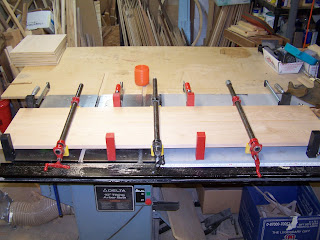Finally, I am getting back to Gary Jr's furniture project(s). I had the legs rough cut before Christmas, then had to stop and get some gifts made. So I started with getting all of the machining marks out of the legs, starting with 60 grit sandpaper (and files) and taking them through 220 grit sandpaper. Next, I made the stretchers, the pieces of wood which hold the legs together. Then I glued them all together:


The two coffee tables will have a drawer, so you will notice the stretcher at the front of the table has a space for a drawer. The "occassional" table, the square one, will have a wood frame top with an inset piece of glass and no drawer.
The next step was to make the drawers. I have a router table I made, which is permanently setup to make the cuts for dovetail joints. One router cuts the holes for the dovetail pins, and the other router is setup to cut the dovetail pins. The next picture shows the cutter used to make the tapered holes the pins are inserted into:

The side shown below is the one used to cut the holes for the pins. The apparatus behind the router bit is used to collect the wood chips and dust as the cuts are made:

I use a template which is mounted on a block of wood. The drawer sides are clamped to the dovetail jig. For this operation, I can clamp both drawer sides and route them together. When the routing on one side is done, the sides are unclamped, rotated 180 degrees, and the other end of the side is routed.

When all four pieces are routed, I dry-fit the parts together to make sure everything looks OK. Dovetail jigs can be finicky, and it's best to check before cutting a lot of drawer parts, only to discover the parts do not line up as planned. These joints looks pretty nice:

After the dry-fit, I take the drawer apart and set it aside. Next I made the drawer bottoms. For this project I decided to make the entire drawer out of walnut. So I took a 1" thick piece of walnut and re-sawed it with my band saw to a thickness of 5/16". Then I put the pieces through the planer to machine them to 1/4". I have a special router bit I use to route a 1/4" by 1/4" slot all the way around the interior of the drawer box. That's where the drawer bottom will go, as the drawer box is assembled.
I use polyurethane glue on the dovetail joints. I found this glue to be very strong, and it fills in any minor gaps in the joints. It also doesn't tend to stain the wood. But just to be sure, I put blue painter's tape around the joints so any excess wouldn't get into the walnut. Once glued and assembled, I check for squareness, then put a few clamps on them til they are dried:


Next entry: drawer box sanding and installing drawer guides on the tables.




































